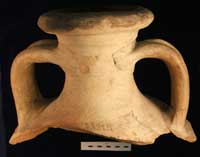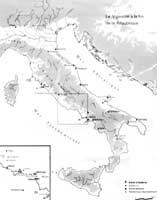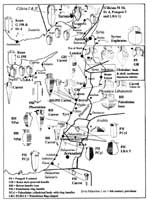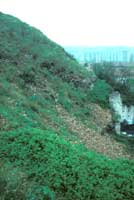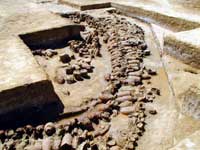Roman Amphorae: a digital resource
University of Southampton, 2005. (updated 2014) https://doi.org/10.5284/1028192. How to cite using this DOI
Data copyright © University of Southampton unless otherwise stated
This work is licensed under the ADS Terms of Use and Access.
Primary contact
Dr
David
Williams
Dept of Archaeology
University of Southampton
Avenue Campus
Highfield
Southampton
SO17 1BJ
England
Tel: 080 593032
Resource identifiers
- ADS Collection: 463
- DOI:https://doi.org/10.5284/1028192
- How to cite using this DOI
Introduction
- Aims of the website
- The Significance of Roman Amphorae
- The Development of Amphora Studies
- Development of the Roman amphora tradition
- Amphorae and Trade within the Roman empire
- Amphorae and Trade beyond the Roman empire
- Characterization of amphorae
Aims of the website
The aim of this website is to provide an online introductory resource for the study of Roman amphorae. In the Roman empire amphorae were pottery containers used for the non-local transport of agricultural products. Their fragments litter archaeological sites of all kinds on land and at sea and have been a subject of serious study for over 100 years. They are crucially important to archaeologists in providing direct evidence for inter-regional and long-distance movement of agricultural products within the empire, and have been an important source of data in the increasingly sophisticated debates about the scale and structure of the Roman economy over the last thirty years. While the study of amphorae also encompasses the stamps, painted inscriptions (tituli picti) and production sites, this website concentrates upon the containers alone.
Recent research means that we now know more about the origins, contents and trading patterns of amphorae than ever before. Nevertheless, the field is a highly complex one, particularly for the non-specialist. Large numbers of amphora sherds in museum basements and on archaeological sites across Europe attest to the scale of the amphora trade. Furthermore, research in recent years has revealed that there are very considerable regional variations in the form and clay fabric of amphorae across the Roman empire. Finally, although there is an established framework of study for Roman amphorae, contrasting academic traditions have led to significant differences in approach to their study, particularly in recent years. This is an issue that has been exacerbated by the publication of new data and studies in journals and conference volumes that are often difficult for even the specialist to locate. There are thus only a few archaeologists working in any one country, or region, who can readily relate their finds to published material in another, with any degree of confidence. All of this makes it difficult to gain an overall sense of the full range of amphora production in the Roman provinces.
The ideal solution would be to "democratize" amphora studies so that the same range of information could be within reach of all scholars irrespective of country, the quality of libraries or the availability of comparative material. This would allow better informed identifications of amphora finds on archaeological sites, leading to the unsuspected "appearance" of new types in different regions for the first time and, as a consequence, a better appreciation of the flows of trade across the provinces of the Roman empire than is possible at the moment. This remains as yet an unattainable dream given the sheer range of types and fabrics. However, this website is intended as a first step in this direction.
The established amphora specialist will be familiar with much of what is presented here. This is because it is aimed at archaeologists unfamiliar with amphorae, curators in museums and students interested in finding their way around the subject of Roman amphorae. Its key feature is that it provides consistently recorded details of form and fabric for each type in a way that will allow for a much broader range of possible comparanda for any one form or fragment than has hitherto been possible. It is hoped that it will thus provide sufficient basic information for the non-specialist to be able to navigate their way around the main amphora types and their often confusing naming systems, discover the main works of reference associated with them, and attempt preliminary identifications of amphora sherds.
The Significance of Roman Amphorae
It is difficult to underestimate the importance of amphorae to our understanding of trade and commerce in the Roman empire. They were primarily designed to transport agricultural produce over long distances, particularly by sea, and are one of the most common finds on Roman archaeological sites of all kinds, especially in the Mediterranean region. They provide a ready source of information about the production, transport and supply of foodstuffs across the Roman empire. Amphorae were in essence the trade packaging of the ancient world. They come in a bewildering variety of forms and sizes. Most commonly they appear as relatively large and heavy cylindrical (Dressel 1), cylindrical (Dressel 2-4 Italian) or globular vessels (Dressel 20) with two handles and a spike, designed primarily for the transport of liquid commodities such as wine, olive oil or fish sauces. Since they would not stand upright unsupported, they were designed particularly for maritime transport. Excavations on Roman shipwrecks such as the Madrague des Giens off the coast of Provence (Tchernia et alii, 1978) have revealed that amphorae were stacked in the hold for transport with their spikes occupying the voids between amphorae in the layer below: on land, by contrast, the spike would have acted as a handle to facilitate pouring. There are, however, a number of smaller, thin-walled, flat-bottomed forms (such as the Dressel 28 and many of the Gauloise series) which must have been protected from damage while being transported by covering them with straw.
Amphora forms can vary from one region to another so that, in conjunction with information recorded on stamps and tituli picti, they can inform the purchaser about origin and contents, in a manner akin to modern trade packaging. This is particularly true of the southern Spanish Dressel 20 which carried olive oil from the province of Baetica. However, since many types, such as the Dressel 2-4, were produced in Italy and copied in areas as far apart as Hispania Tarraconensis and Baetica, Gallia Narbonensis, Africa, Egypt and Britain, the form of the vessel alone could misinform the consumer about the origin, if not the content.
The Development of Amphora Studies
The first time that Roman amphorae became an issue of intrinsic interest was with the publication of a group of amphorae from the Castro Pretorio at Rome in a synoptic table by Heinrich Dressel in the late 19th century (Dressel, 1899).
The main purpose of the table was to illustrate the vessels upon which stamps and tituli picti from the site were found. Some forty five individual shapes were represented in outline form on a table that has exercised a considerable hold over the minds of scholars ever since, unwittingly providing the framework for much future study of amphorae.
This early work was followed up by several studies that began the long process of establishing and refining the chronology and sources of these vessels that continues to this day.
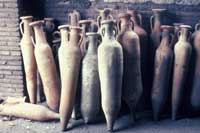
Assorted African Amphorae, currently
in the Museo dei Fori Imperiale
e Mercati Traianei, that were
originally used in Dressel's
Synoptic Table
(Dressel, 1899)
However, it was without doubt the works of Zevi (1966), and Zevi and Tchernia (1969) that began to reveal the potential of amphorae as an index of Roman economic activity and seaborne trade. At the same time excavations by Carandini and his team at Ostia began to explore the full range of amphora material in archaeological excavation and to get to grips with the complex problem of assigning dates of manufacture (particularly Carandini and Panella 1973; 1977). The economic implications of this kind of work in the western Roman provinces began to be developed in key works and conferences on Roman amphorae in the 1970s (for example Vallet, 1977). In the course of the 1980s, amphora studies blossomed (perhaps best exemplified by, Empereur and Garlan, 1986; Lenoire, Manacorda and Panella, 1989). The excavation and publication of production sites in the western and eastern areas of the Roman empire, together with greater emphasis on the importance of nuances in fabric as well as form (viz. Peacock 1971; 1977d), greatly enhanced the range and chronology of known types, and started to provide information about production sites. It also helped to break down the established certainties about the origin of key types, such as the Dressel 2-4 Italian, which were found to have been manufactured in many different parts of the empire, and their contents. Important advances were also made in exploring the potential of amphorae in contributing to economic histories of the Roman empire, both the west and the east, down to the late antique period (Tchernia, 1986; Panella, 1993; Reynolds, 1995). The growing awareness of the potential of amphorae in this regard has led to a further intensity in amphora research in recent years, with the less well understood potential of the eastern Mediterranean beginning to be unlocked (see most recently Eiring and Lund, 2004). All of this has led to what one might term a regionalization of amphora studies across the Roman empire. Conferences on a range of amphora-based topics in a range of European countries have focused upon new evidence for the rhythms of amphora production from a regional perspective, enabling important contributions to be made to on-going debates about the provenance, chronology and content within the broadly established framework for the empire as a whole (see for example Gurt Esparraguera et alii, 2004). This is the context within which some kind of common language in terms of form and fabric is needed for the non-specialist.
The stamps and tituli picti which are sometimes found on certain types of amphorae are not a subject of specific study in this website. Nevertheless, a number of the amphora types on this website have direct links to the stamp catalogue hosted by CEIPAC (see under Usage). The complex range of interpretative issues associated with them demands separate platforms for their presentation. Stamps were abbreviated names and symbols impressed on to the handles, rims or necks of amphorae, while tituli picti were inscriptions painted onto different parts of amphorae after firing.
Together, they provide valuable information about the involvement of individuals and places in the production and transport of amphorae, particularly during the republican and early imperial periods (introductory discussion in Peacock and Williams, 1986, 9-14). Much of the information concerning stamps and tituli picti was initially collected by Dressel (1879; 1899) in the Corpus Inscriptionum Latinarum and, in recent years, has been hugely supplemented by numerous corpora that have incorporated material from across the Roman empire. Callender (1965) provided the first synthesis of this kind of information. As far as stamps are concerned, his work has been long made redundant by a myriad of studies fuelled by the discovery of ever larger numbers of more stamped amphorae in excavations. They have been analyzed from the perspective of individual sites (such as Maier-Maidl, 1992; Bezecky, 1998b; Martin-Kilcher, 1994), regions (such as Mayet, 1978), or of individual productions (such as Desy, 1989, Laubenheimer, 1985; Funari, 1996; Remesal Rodríguez, 1997; Miró, 1988 and Pascual Guasch, 1991). However, as with the amphorae themselves there is a need to rise above the local and regional and in the case of stamps to create over-arching corpora that allow individual finds from across the Roman empire to be looked at in context. There are currently three ongoing projects that are doing this (Carre at al 1995; Blanc-Bijon 1998; Panella and Moizio forthcoming;). Tituli picti are found rather more rarely, usually in extremely damp or dry conditions, coming from shipwrecks (for example Colls, et alii 1977; Liou, 1987), sites in the north-western Roman provinces (see for example those listed in Frere and Tomlin, 1994), the Monte Testaccio at Rome (Rodríguez Almeida, 1984; Blázquez Martínez and Remesal Rodríguez, 2003).
Both stamps and tituli picti have been the subject of intense and wide-ranging research which has enhanced our understanding of the production, distribution and consumption of foodstuffs, the people involved and broader economic structure of the Roman empire. An idea of the flavour of recent debates on these issues can be found in contributions to Harris (1993) and Remesal Rodríguez (2004).
Development of the Roman amphora tradition
The origins of the amphora as a container for transporting agricultural produce are to be sought in the north Lebanese-Syrian coastal region as far back as the fifteenth century BC, becoming increasingly common in the content of Phoenician and Greek trading systems in the Mediterranean during the earlier first millennium BC (Peacock and Williams 1986, 20ff).
Roman amphora shapes seem to have developed initially out of Roman contacts with the Greeks in southern Italy and Sicily and the eastern Mediterranean during the later fourth and third centuries BC. The earliest forms (particularly the Greco-Italic, Dressel 1 and Lamboglia 2) were manufactured in Italy, although by the middle of the first century BC, significant production of amphorae had begun in Mediterranean provinces, such as Hispania Tarraconensis and Baetica (such as the Pascual I form).
The early imperial period in the western empire saw a gradual shift away from large-scale amphora production in Italy. It was increasingly centred on the provinces of Hispania Tarraconensis and Baetica (such as the Dressel 2-4 Baetican, Dr. 20 and Dr.7, 8, 9, 10, 11 forms), Africa Proconsularis (such as the Africana 1 Piccolo and 2A, and Ostia 59 forms), Tripolitania (such as the Tripolitana 1 and 2 forms) and Gallia Narbonensis (such as the Gauloise 4 form).
Manufacture was often on a large scale, driven by the food requirements of the City of Rome and army units stationed on the frontiers of the empire, although most provinces including Italy have yielded good archaeological evidence for amphora production until at least the third century AD. Amphora production also abounded in the eastern Mediterranean, centred on a range of provinces including Cilicia (Pompeii 13 and Pompeii 5), Judaea (Carrot and Late Roman 5 and 6) and Egypt (Egyptian Dressel 2-4 Type). The amphorae of this period are often heavy and cumbersome, with a poor ratio between payload and 'dead' clay. Exceptions are, of course, the flat-bottomed types (such as the Spello type) that are produced widely in Italy, Gaul, Hispania and north Africa.
One of the most exciting results of recent archaeological work in both the west and eastern Roman empire has been to show that the late imperial period down to the sixth century and beyond witnessed amphora production on a greater scale than had been hitherto appreciated (Keay 1984). Production in the western Mediterranean was focused primarily on north Africa, principally the province of Zeugitana, and is characterized by lighter cylindrical forms (such as Africana 3A, B and C and Keay 62A, D & E) which carried more commodity for less clay weight.
This innovation may be related to improving skills in the pottery industry or perhaps to different organization of production away from the estate to more specialized modes. Vigorous manufacture of relatively small and varied forms continued in the east Mediterranean, including along the coasts of Asia Minor, Syria, Palestine and Cyprus (such as Late Roman Amphora 1, 5 and 6) (Reynolds, 2005a), and down the Nile valley of Egypt (such as the Late Roman Amphora 7) (Majcherek, 2004).
This was driven, in part at least, by the consequences of the establishment of Constantinople as a new centre of power in the earlier fourth century, as well as the continued prosperity of towns.
Amphorae and Trade within the Roman empire
Amphorae provide one of the most important sources of evidence for the tracing the supply of foodstuffs to Rome and the frontiers, as well as flows of trade across the empire. In particular, they were par excellence the vessels of maritime trade in the Roman empire. Excavations and surveys in recent years have demonstrated clearly their abundant presence on wrecks (Parker, 1992), ports (Keay, Millett, Paroli, and Strutt, 2005; www.arch.soton.ac.uk/Projects/Portus) and at towns across the Roman empire. Indeed, they were sometimes discarded in large dumps when they finished their original journey and had been emptied of their contents. This is best exemplified by the massive hill of amphora fragments at Monte Testaccio on the outskirts of Rome (Rodríguez Almeida, 1984; forthcoming): these came primarily from Hispania Baetica (Dressel 20 and 23 forms) and north Africa (such as the Tripolitania I, and Africana I).
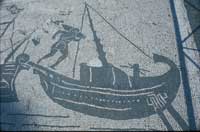
Mosaic illustrating amphorae
being unloaded from a ship
(Piazzale delle Corporazione, Ostia)
Simon Keay
Furthermore, the presence of amphorae at a range of rural settlements, albeit in lesser quantities, in many different parts of the empire is eloquent testimony to the efficiency of provincial distribution networks. Military camps along the frontiers of the empire, particularly along the Rhine and Danube and in Britain, were another key destination for amphorae (Rodríguez Remesal, 1986; Carreras Monfort, 2000). Analysis of amphora fragments from all these contexts can tell us much about the economy of the Roman empire as well as the tastes and dietary preferences of sectors of society in Italy (Tchernia, 1986) and other provinces or regions. In doing this, much has to be made from form and fabric, since stamps and tituli picti are rare outside the Mediterranean area. However, where conditions do permit, this kind of written evidence from the vessels themselves can furnish invaluable insights into the estates where these vessels were produced, as well as their contents and date.
Amphorae and Trade beyond the Roman empire
Amphorae produced in the Mediterranean region were a truly international type of pottery. While it is common knowledge that Roman amphorae abound within the confines of the Roman Empire, it should be realized that they were also in demand outside it. In parts of Iberia and much of Gaul, for example, amphorae were important items of trade between Roman merchants and traders in key native settlements prior to their conquest by Rome between the second century BC and the first century AD (for example Fitzpatrick, 1985). Furthermore, during the imperial period they also found their way in quantity across the Rhine and Danube frontiers into central Europe, into parts of southern Libya, Tunisia and Algeria and down the Red Sea to Arabia and India (Wheeler, 1955).
Not only do these amphorae have much to tell us about trading links between the Roman empire and its neighbours, but also something about the tastes and social structures of these non-Roman peoples.
Characterization of amphorae
Amphorae were originally studied as a supplement to stamps and tituli picti from excavations in Rome that were published by Dressel in the late nineteenth century. However, once their potential value as indicators of trade had been realized, the shape of the vessel became a focus of study. Early scholars such as Pélichet (1946), Lamboglia (1955) and Almagro (1955) attempted to supplement Dressel's table with new shapes as they were recovered from archaeological excavations of specific sites. This is a practice that continues down to the present-day with scholars developing typologies based upon increasing quantities of archaeological material from sites, production areas, regions or countries. As a result existing typologies have been extended or, where necessary, new ones created. Up until the later 1970s scholars generally used these typologies as frames of reference for elucidating the origins of defined groups of amphorae. This was achieved through comparison of the shape of unknown forms to those for which an origin had been suggested on the basis of form, parallels with material from excavated kiln sites (rarely), or information gleaned from stamps or tituli picti.
It was, however, becoming increasingly apparent that similarly shaped amphorae forms were in fact produced at many widely dispersed centres around the Mediterranean and even beyond. Indeed many amphora forms were also "copied" by secondary centres for reasons which are not entirely clear at present. This meant that shape alone was insufficient to adequately characterize amphorae or to attempt to ascertain their origins.
Important work by Peacock (1971; 1977d) revealed the potential of analyzing the physical characteristics of the clay in tracing the origins of amphorae. His work has been complemented by a number of other scholars in more recent years, including David Williams and Maurice Picon. Hitherto, scholars had simply noted the colour of the fabric - something which in itself tells us very little. Peacock recognized that the clay fabric of amphorae and other kinds of coarse pottery often contain mineral inclusions that are sufficiently distinctive to the eye to be identified and then related to characteristic geological outcrops close to where the pottery was originally manufactured. The most frequently used method involves analysis of hand-specimens with an x10 hand lens backed up by closer study with a polarizing microscope. Its success relies upon the fabric containing mineral inclusions that are sufficiently distinctive to be ascribed to a single source. Its advantage is that if an amphora has a distinctive fabric, it can be detected from the small fragments that are the most usual form in which amphorae are found. However, since many areas of the Mediterranean have a fairly uniform limestone-based geology, the number of amphora forms that can be readily recognized by this method alone are generally limited. Those that are most distinctive include the "Black Sand" fabric of the Bay of Naples region, characterized by an abundance of small glassy dark-coloured grains of pyroxene, mostly augite, scattered throughout the clay of the vessel (Peacock, 1977d; Williams and Peacock, 2005). The "granitic" fabric of some Catalan amphorae (Tchernia and Zevi, 1972; Williams, 1981) and the gritty heterogeneous Dressel 20 and 23 fabric from the Guadalquivir Valley of southern Spain (Peacock and Williams, 1986, Classes 25 and 26) are other good examples. The provenance of amphora can also be deduced from chemical analysis. While fabric analysis represented a major advance in the way that amphorae are characterized and sourced, the more traditional approaches are still used.





